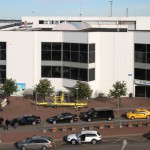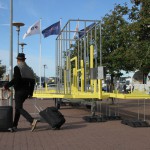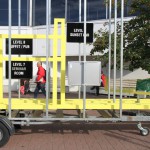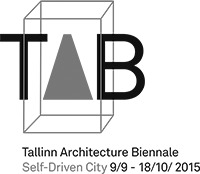Boris J., 62, investor and manager from St. Petersburg, Russia. He travels the 320 km to Estonia 4 times a year.
Galina M., 28, skilled primary school teacher, currently waitress, from Jõhvi, Estonia. Since 3 years she is fully employed by Tallink Silja Line.
Januš. F. 47, truck driver, from Poznan, Poland. He is a one-man company and since 7 years the owner of a second hand Volvo FH 12, a 16.5 meters and 40 tons semitrailer truck, who transports cargo between Poland, Finland and Russia.
Rainer O., 37, construction worker from Tartu, Estonia. Since 9 years he commutes weekly or at least every second week between Tartu and Helsinki. Since five years he works for his own small two-man construction company operating in the Helsinki region.
Anita L., 46, export-manager from Wuppertal, Germany. Since more then ten years she travels to Finland and Estonia in about three combined trips per year – to visit potential customers for a German company manufacturing door panels.
Olli M. 27, car mechanic from Sipoo, Finland. Together with friends he uses to travels for a one day cruise to Tallinn about three times per year – to enjoy holidays and party on.
Siret H., 53, accountant from Tallinn, Estonia. Since the fall of communism in 1989 she frequently travels to Helsinki.
Voices: Tõnu Karjatse, Margitta Otsmaa
ON+ OFF.
(Dis-)Embarking
Rhythms of Transient Communities
A Network Installation by Stop and Go PORT of TALLINN Public Space in front of Terminal D, Lootsi 13, Tallinn
From September 10 to 20, 2015 9:30 to 20:00
Opening Reception: Wednesday, Sept. 9, 16:00
Introduction by representatives of the Port of Tallinn and the project team
Set up in the public space of the Tallinn harbour area, this intervention is both a part of a research project and a contribution to the satellite programme of the Tallinn Architecture Biennale “TAB 2015 Self-Driven City”. A conventional trailer for boats has been adapted for use as a part of a mobile research lab, e.g. as a drawing board for large-scale two-dimensional mappings done on tour or, in this case, as a supporting structure for a larger scale three-dimensional installation. On the macro-level this network installation represents an abstract map of the paths of individuals travelling from their departure point to their target destination with a ferry line operating regularly between Tallinn and Helsinki. Via integrated loudspeakers the visitors of the installation can listen to narratives about the actors’ motives, rhythms, rituals, and routines parallel to their routes. These micro-narratives relate both to the individuals’ biographies and to more general historic, political, and economic transformations of the Baltic area, thereby interrelating transnational mobility flows and place-making in very specific sites. Moreover, these stories address socio-cultural/economic differences and effects that cause, among other things, (labour) migration and cross-border investment and consumption. Paths and narratives are based on interviews done on site, but the characters are partly fictionalized to widen the scope of experiences. The installation does not intend to represent the final results of the larger research project rather to trigger further expertise from mobile individuals passing by during the period of construction and exhibition.
Bus Tour And Public Workshop
Thursday, Sept. 17 11:00 to 17:30
The specific geopolitical location and the recent political and socio-economic transformation of Tallinn also triggered and redirected routes and patterns of transnational mobility and migration between the Baltic realm, Russia, Scandinavia, and Central Europe. These streams of mobility show an influx on the transformation of urban space while individuals and groups develop new methods to appropriate and make sense of these spaces. The bus tour will follow flows of mobility and visit relevant sites, e.g. wholesale markets, logistic hubs for processing goods, real estate projects for foreign investment such as the BLRT harbour front re-developments, nodes for transnational mobility like the current Tallinn harbour terminals, whose massive influx of passengers has an enormous impact on the perception and production of spaces in Tallinn. Project presentations by guests will open a wider scope of scientific and artistic works related to the issue of mobility and transformation.
11:00 to 13:00 Thematic Presentations Port of Tallinn, D-Terminal Lootsi 13, 3rd floor, travel transit zone
Damiano Cerrone,A sense of place: Hacking the invisible city through social media
Ingrid Ruudi,Naissaar: extraterritorial utopian zone of the transitional era
Jaak Kilmi,Stories about the Finnish TV and other influx during the Soviet time
Keiu Telve,Estonian commuters in Finland – The good migrants
Moderated by Tarmo Pikner, Michael Hieslmair and Michael Zinganel
14:30 to 17:30
Guided Bus Tour Point of Departure Port of Tallinn, D-Terminal Lootsi 13, main entrance at ground floor
All events are free or charge Please register before September 15
via e-mail to Tarmo Pikner tpikner@tlu.ee
Damiano Cerrone is co-founder and coordinator at SPIN Unit, a transnational urban research group combining art and science to find new and creative approaches to urban studies and advanced data solutions. Damiano is also principal researcher at TERREFORM New York. This year he received the Young Scholar award at the ESRI UC in San Diego.
Ingrid Ruudi is an architecture historian, critic, and curator working at the Estonian Academy of Arts, Institute of Art History. Her research focuses on issues of built environment, public space, and critical interventions from the late Soviet period to the contemporary era. She has curated the Estonian exhibition “Gas Pipe” at the 11th Venice Architecture Biennale in 2008, co-curated the Urban Installations Festival LIFT11 in 2011, and initiated and curated the open project space März in Tallinn in 2010–2011. Her latest exhibition “Unbuilt. Visions for a New Society 1986–1994” at the Museum of Estonian Architecture this year investigated unrealised architectural and urban propositions of the transitional era.
Jaak Kilmi is a film director. He has created several documentary films reflecting on transformations in Estonian society, e.g. “Disco and Atomic War“, “The New World”, “The Art of Selling”, “The Paper City”. Besides the production of documentary and feature films, Kilmi has cooperated with several TV channels and published film reviews. He has taught in the field of documentary film at Baltic Film and Media School.
Keiu Telve, PhD researcher of ethnology at the University of Tartu. She studies Estonian men commuting between Finland and Estonia. Her research focuses on the following themes: how men perceive the mobility between the countries, how multiple affinities can be hold, and the changes in behaviour patterns along the work-related commuting routes.




